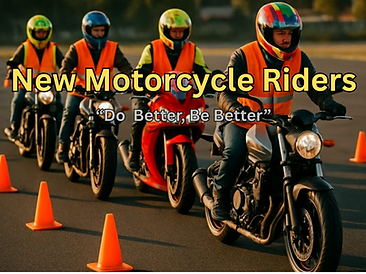Optimal Lane Positioning for Motorcycle Safety and Control Unveiled
- NMR

- May 19
- 4 min read
Motorcycling is not just about getting from point A to point B; it's an exhilarating blend of freedom and adventure. Yet, it is vital to acknowledge the risks involved in riding. A key element in riding safely is understanding lane positioning. Knowing how and where to position yourself in the lane maximizes safety, enhances control, and improves maneuverability. In this post, we will explore effective lane positions for motorcycle riders, highlighting the importance of visibility, hazard management, and safety.
Understanding Lane Positioning
Lane positioning is simply where you place your motorcycle within a lane on the road. Choosing the right lane position can significantly affect your safety in various riding situations. For example, a study from the NHTSA shows that motorcyclists are five times more likely to be injured than car occupants, making awareness of lane positioning even more essential. By positioning yourself correctly, you can increase your visibility to other road users, give yourself more time to react to hazards, and enjoy a more controlled riding experience.
Riders must particularly pay attention to their lane position in busy urban environments. For instance, lane splitting is a technique where motorcyclists pass through slow or stopped vehicles. This maneuver requires skill and a deep understanding of lane dynamics to execute safely.
The Three Lane Positions
Motorcyclists generally have three positions to choose from within their lane: left, center, and right. Each offers unique advantages based on the situation.
Left Position
Riding close to the left side of the lane offers various benefits:
Visibility: This position improves your visibility to oncoming traffic and vehicles merging from side roads. For example, studies indicate that riders in the left position are seen by 80% of drivers in oncoming vehicles.
Escape Route: If a nearby vehicle encroaches into your space, the left position serves as an escape route, offering quick access to the shoulder or the left lane.
Cornering: Approaching a left turn while in the left position allows for smoother cornering and minimizes the risk of being cut off by turning vehicles.
However, keep in mind that the left side of the lane can harbor debris and potholes, which may pose hazards. Riders should always scan for these before adopting this position.
Center Position
The center position places the rider in the middle of the lane, balancing visibility and control. Here is when this position proves helpful:
Safe Following Distance: Being in the center allows for a greater distance between the motorcycle and the vehicle in front. This distance helps in reacting to unexpected stops. According to the Motorcycle Safety Foundation, maintaining a three-second following distance can significantly reduce crash risks.
Lateral Space: The center position ensures you have space on both sides for quick maneuvers should an obstacle arise.
Comfortable Lean Angle: In turns, this position optimizes the motorcycle’s handling, allowing for a stable and controlled lean.
But remember, while in the center position, you might be less visible to others, especially at intersections.
Right Position
The right position, where you ride closer to the right side of the lane, has specific use cases:
Intersections: This position enhances visibility to left-turning vehicles, allowing for smoother navigation through intersections.
Parked Cars: When approaching parked vehicles, being closer to the right side gives you more distance from potential door swings, reducing the risk of accidents.
Wind Protection: In windy conditions, this position can offer added protection from gusts, creating a more comfortable ride.
Despite its benefits, riders must remain vigilant for hazards on the right side of the lane, such as debris and damaged pavement.
Factors Affecting Lane Positioning
Various factors can influence the best lane position for any given scenario:
Road Conditions
Always be on the lookout for road irregularities like potholes and debris. Adapting your lane position according to these conditions will enhance safety. For instance, riding too close to the shoulder during rain can be slippery and unsafe.
Traffic Flow
In heavy traffic, understanding how surrounding vehicles behave is crucial. Adjust your lane position to maximize your visibility and ensure safety, especially in stop-and-go situations.
Weather Conditions
Adverse weather can drastically affect visibility and control. For example, during rainy conditions, adjusting your lane position to avoid painted road lines, which can be slippery, is essential.
Surrounding Vehicles
Be mindful of larger vehicles like trucks, as they can create blind spots that affect your visibility and safety. For instance, staying slightly ahead or behind these vehicles can help prevent being in their blind spots.
Riding Experience
While experienced riders may have a better knack for lane positioning, it’s still important for everyone to continuously assess and adapt to their surroundings.
General Safety Tips for Lane Positioning
Stay Alert: Consistently remain aware of your environment. Keep an eye on the actions of surrounding vehicles and potential hazards.
Communicate: Use hand signals and turn signals to clearly indicate your intentions to other drivers.
Practice Defensive Riding: Adopt a riding approach that anticipates the actions of other road users. For instance, always assume that a driver may not see you.
Continuous Learning: Consider enrolling in advanced motorcycle safety courses to refine your understanding and skills in lane positioning.
Mastering Lane Positioning
Understanding and mastering optimal lane positioning is essential for every motorcyclist. By considering the unique advantages of the left, center, and right positions, riders can significantly enhance their visibility, control, and safety on the road. Always take into account factors like weather, traffic flow, and road conditions. This adaptability allows for a riding approach that prioritizes safety.
Motorcycling should be an exhilarating yet secure experience. Always stay aware of your lane positioning, as it is a key factor in how other road users perceive and respond to you. By focusing on these strategies, riders can enjoy every ride while minimizing risks.






.png)



Comments